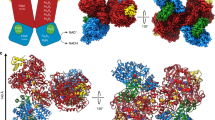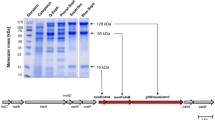Abstract
Formate transport across the inner membrane is a critical step in anaerobic bacterial respiration. Members of the formate/nitrite transport protein family function to shuttle substrate across the cytoplasmic membrane. In bacterial pathogens, the nitrite transport protein is involved in protecting bacteria from peroxynitrite released by host macrophages. We have determined the 2.13-Å structure of the formate channel FocA from Vibrio cholerae, which reveals a pentamer in which each monomer possesses its own substrate translocation pore. Unexpectedly, the fold of the FocA monomer resembles that found in water and glycerol channels. The selectivity filter in FocA consists of a cytoplasmic slit and a central constriction ring. A 2.5-Å high-formate structure shows two formate ions bound to the cytoplasmic slit via both hydrogen bonding and van der Waals interactions, providing a structural basis for the substrate selectivity of the channel.
This is a preview of subscription content, access via your institution
Access options
Subscribe to this journal
Receive 12 print issues and online access
$189.00 per year
only $15.75 per issue
Buy this article
- Purchase on Springer Link
- Instant access to full article PDF
Prices may be subject to local taxes which are calculated during checkout





Similar content being viewed by others
References
Stokes, J.L. Fermentation of glucose by suspensions of Escherichia coli. J. Bacteriol. 57, 147–158 (1949).
Sawers, G. The hydrogenases and formate dehydrogenases of Escherichia coli. Antonie Van Leeuwenhoek 66, 57–88 (1994).
Clegg, S., Yu, F., Griffiths, L. & Cole, J.A. The roles of the polytopic membrane proteins NarK, NarU and NirC in Escherichia coli K-12: two nitrate and three nitrite transporters. Mol. Microbiol. 44, 143–155 (2002).
De Groote, M.A. et al. Genetic and redox determinants of nitric oxide cytotoxicity in a Salmonella typhimurium model. Proc. Natl. Acad. Sci. USA 92, 6399–6403 (1995).
Shiloh, M.U. et al. Phenotype of mice and macrophages deficient in both phagocyte oxidase and inducible nitric oxide synthase. Immunity 10, 29–38 (1999).
Chakravortty, D. & Hensel, M. Inducible nitric oxide synthase and control of intracellular bacterial pathogens. Microbes Infect. 5, 621–627 (2003).
Das, P., Lahiri, A. & Chakravortty, D. Novel role of the nitrite transporter NirC in Salmonella pathogenesis: SPI2-dependent suppression of inducible nitric oxide synthase in activated macrophages. Microbiology 155, 2476–2489 (2009).
Saier, M.H. Jr. et al. Phylogenetic characterization of novel transport protein families revealed by genome analyses. Biochim. Biophys. Acta 1422, 1–56 (1999).
Delomenie, C. et al. A new homolog of FocA transporters identified in cadmium-resistant Euglena gracilis. Biochem. Biophys. Res. Commun. 358, 455–461 (2007).
Sawers, G. & Bock, A. Novel transcriptional control of the pyruvate formate-lyase gene: upstream regulatory sequences and multiple promoters regulate anaerobic expression. J. Bacteriol. 171, 2485–2498 (1989).
Suppmann, B. & Sawers, G. Isolation and characterization of hypophosphite–resistant mutants of Escherichia coli: identification of the FocA protein, encoded by the pfl operon, as a putative formate transporter. Mol. Microbiol. 11, 965–982 (1994).
Jia, W., Tovell, N., Clegg, S., Trimmer, M. & Cole, J. A single channel for nitrate uptake, nitrite export and nitrite uptake by Escherichia coli NarU and a role for NirC in nitrite export and uptake. Biochem. J. 417, 297–304 (2009).
Garty, H., Rudy, B. & Karlish, S.J. A simple and sensitive procedure for measuring isotope fluxes through ion-specific channels in heterogenous populations of membrane vesicles. J. Biol. Chem. 258, 13094–13099 (1983).
Middleton, R.E., Pheasant, D.J. & Miller, C. Purification, reconstitution, and subunit composition of a voltage-gated chloride channel from Torpedo electroplax. Biochemistry 33, 13189–13198 (1994).
Walden, M. et al. Uncoupling and turnover in a Cl−/H+ exchange transporter. J. Gen. Physiol. 129, 317–329 (2007).
Law, C.J., Maloney, P.C. & Wang, D.N. Ins and outs of major facilitator superfamily antiporters. Annu. Rev. Microbiol. 62, 289–305 (2008).
Murata, K. et al. Structural determinants of water permeation through aquaporin-1. Nature 407, 599–605 (2000).
Fu, D. et al. Structure of a glycerol-conducting channel and the basis for its selectivity. Science 290, 481–486 (2000).
Sui, H., Han, B.G., Lee, J.K., Walian, P. & Jap, B.K. Structural basis of water-specific transport through the AQP1 water channel. Nature 414, 872–878 (2001).
Walz, T., Smith, B.L., Zeidel, M.L., Engel, A. & Agre, P. Biologically active two-dimensional crystals of aquaporin CHIP. J. Biol. Chem. 269, 1583–1586 (1994).
Stroud, R.M. et al. Glycerol facilitator GlpF and the associated aquaporin family of channels. Curr. Opin. Struct. Biol. 13, 424–431 (2003).
Walz, T., Fujiyoshi, Y. & Engel, A. The AQP structure and functional implications. Handb. Exp. Pharmacol. 190, 31–56 (2009).
Jiang, J., Daniels, B.V. & Fu, D. Crystal structure of AqpZ tetramer reveals two distinct Arg-189 conformations associated with water permeation through the narrowest constriction of the water-conducting channel. J. Biol. Chem. 281, 454–460 (2006).
Lawrence, M.C. & Colman, P.M. Shape complementarity at protein/protein interfaces. J. Mol. Biol. 234, 946–950 (1993).
Karpowich, N.K. & Wang, D.N. Structural biology. Symmetric transporters for asymmetric transport. Science 321, 781–782 (2008).
Ashcroft, F., Gadsby, D. & Miller, C. Introduction. The blurred boundary between channels and transporters. Phil. Trans. R. Soc. Lond. B 364, 145–147 (2009).
Zhou, Y. & MacKinnon, R. The occupancy of ions in the K+ selectivity filter: charge balance and coupling of ion binding to a protein conformational change underlie high conduction rates. J. Mol. Biol. 333, 965–975 (2003).
Garrett, T.P., Clingeleffer, D.J., Guss, J.M., Rogers, S.J. & Freeman, H.C. The crystal structure of poplar apoplastocyanin at 1.8-Å resolution. The geometry of the copper-binding site is created by the polypeptide. J. Biol. Chem. 259, 2822–2825 (1984).
Schmiedekamp, A. & Nanda, V. Metal-activated histidine carbon donor hydrogen bonds contribute to metalloprotein folding and function. J. Inorg. Biochem. 103, 1054–1060 (2009).
Miyazawa, A., Fujiyoshi, Y. & Unwin, N. Structure and gating mechanism of the acetylcholine receptor pore. Nature 423, 949–955 (2003).
Doyle, D.A. et al. The structure of the potassium channel: molecular basis of K+ conduction and selectivity. Science 280, 69–77 (1998).
Yernool, D., Boudker, O., Jin, Y. & Gouaux, E. Structure of a glutamate transporter homologue from Pyrococcus horikoshii. Nature 431, 811–818 (2004).
Dutzler, R., Campbell, E.B. & MacKinnon, R. Gating the selectivity filter in ClC chloride channels. Science 300, 108–112 (2003).
Hunte, C. et al. Structure of a Na+/H+ antiporter and insights into mechanism of action and regulation by pH. Nature 435, 1197–1202 (2005).
Mosser, G., Mallouh, V. & Brisson, A. A 9 Å two-dimensional projected structure of cholera toxin B-subunit-GM1 complexes determined by electron crystallography. J. Mol. Biol. 226, 23–28 (1992).
Chang, G., Spencer, R.H., Lee, A.T., Barclay, M.T. & Rees, D.C. Structure of the MscL homolog from Mycobacterium tubeculosis: A gated mechanosensitive ion channel. Science 282, 2220–2226 (1998).
Lunin, V.V. et al. Crystal structure of the CorA Mg2+ transporter. Nature 440, 833–837 (2006).
Unwin, N. The structure of ion channels in membranes of excitable cells. Neuron 3, 665–676 (1989).
Khademi, S. et al. Mechanism of ammonia transport by Amt/MEP/Rh: structure of AmtB at 1.35 Å. Science 305, 1587–1594 (2004).
Zheng, L., Kostrewa, D., Berneche, S., Winkler, F.K. & Li, X.D. The mechanism of ammonia transport based on the crystal structure of AmtB of Escherichia coli. Proc. Natl. Acad. Sci. USA 101, 17090–17095 (2004).
Levin, E.J., Quick, M. & Zhou, M. Crystal structure of a bacterial homologue of the kidney urea transporter. Nature advance online publication, doi:10.1038/nature08558 (28 October 2009).
Creighton, T.E. Proteins: Structures and Molecular Properties 335–396 (W.H. Freeman and Company, New York, 1983).
Pusch, M., Ludewig, U., Rehfeldt, A. & Jentsch, T.J. Gating of the voltage-dependent chloride channel CIC-0 by the permeant anion. Nature 373, 527–531 (1995).
Chen, T.Y. & Miller, C. Nonequilibrium gating and voltage dependence of the ClC-0 Cl− channel. J. Gen. Physiol. 108, 237–250 (1996).
Tornroth-Horsefield, S. et al. Structural mechanism of plant aquaporin gating. Nature 439, 688–694 (2006).
Fischer, G. et al. Crystal structure of a yeast aquaporin at 1.15 angstrom reveals a novel gating mechanism. PLoS Biol. 7, e1000130 (2009).
Smart, O.S., Neduvelil, J.G., Wang, X., Wallace, B.A. & Sansom, M.S. HOLE: a program for the analysis of the pore dimensions of ion channel structural models. J. Mol. Graph. 14, 354–360, 376 (1996).
Auer, M. et al. High-yield expression and functional analysis of Escherichia coli glycerol-3-phosphate transporter. Biochemistry 40, 6628–6635 (2001).
Ward, A. et al. Expression of prokaryotic membrane transport proteins in Escherichia coli. Biochem. Soc. Trans. 27, 893–899 (1999).
Miroux, B. & Walker, J.E. Over-production of proteins in Escherichia coli: mutant hosts that allow synthesis of some membrane proteins and globular proteins at high levels. J. Mol. Biol. 260, 289–298 (1996).
Slotboom, D.J., Duurkens, R.H., Olieman, K. & Erkens, G.B. Static light scattering to characterize membrane proteins in detergent solution. Methods 46, 73–82 (2008).
Kendrick, B.S., Kerwin, B.A., Chang, B.S. & Phil, J.S. Online size-exclusion high-performance liquid chromatography light scattering and differential refractometry methods to determine degree of polymer conjugation to proteins and protein-protein or protein-ligand association states. Anal. Biochem. 299, 136–146 (2001).
Wang, D.N., Lemieux, M.J. & Boulter, J.M. Purification and characterization of transporter proteins from human erythrocyte membrane. Methods Mol. Biol. 228, 239–255 (2003).
Otwinowski, Z. & Miror, W. Processing of X-ray diffraction data collected in oscillation mode. Methods Enzymol. 276, Part A, 307–326 (1997).
Adams, P.D. et al. PHENIX: building new software for automated crystallographic structure determination. Acta Crystallogr. D Biol. Crystallogr. 58, 1948–1954 (2002).
Emsley, P. & Cowtan, K. Coot: model-building tools for molecular graphics. Acta Crystallogr. D Biol. Crystallogr. 60, 2126–2132 (2004).
DeLano, W.L. The PyMOL User′s Manual (DeLano Scientific, San Carlos, California, USA, 2002).
Pettersen, E.F. et al. UCSF Chimera—a visualization system for exploratory research and analysis. J. Comput. Chem. 25, 1605–1612 (2004).
Huang, Y., Lemieux, M.J., Song, J., Auer, M. & Wang, D.N. Structure and mechanism of the glycerol-3-phosphate transporter from Escherichia coli. Science 301, 616–620 (2003).
Quick, M. et al. Binding of an octylglucoside detergent molecule in the second substrate (S2) site of LeuT establishes an inhibitor-bound conformation. Proc. Natl. Acad. Sci. USA 106, 5563–5568 (2009).
Acknowledgements
We are grateful to W.A. Hendrickson for support, to M. Punta and B. Rost for bioinformatics analysis of membrane transporters, to B. Kloss for assistance in cloning, and to the staff at beamlines X25 and X29 of the National Synchrotron Light Source in the Brookhaven National Laboratory for assistance in X-ray diffraction experiments. We thank B. Czyzewski, Y. Fujiyoshi, N. K. Karpowich, C.J. Law, X.D. Li, J.J. Marden, R.L. Mancusso, H. Sui, J. Wu, R.M. Xu, N. Unwin, T. Walz, M. Zhou and Z. Zhou for participating synchrotron trips and helpful discussions. This work was financially supported by the Protein Structure Initiative II of the US National Institutes of Health (U54GM075026 to W.A. Hendrickson) and by US National Institute of Diabetes and Digestive and Kidney Diseases (R01-073973 to D.-N.W.). A.B.W. was partially supported by a predoctoral fellowship from the US National Institutes of Health–New York University Graduate Partnership Program in Structural Biology.
Author information
Authors and Affiliations
Contributions
A.B.W. expressed, purified, crystallized and solved the structure of FocA and functionally characterized the protein. J.L. provided the initial clone and measured the protein oligomeric state. D.-N.W. performed electron microscopy. A.B.W. and D.-N.W. wrote the manuscript.
Corresponding author
Supplementary information
Supplementary Text and Figures
Supplementary Figures 1–7 and Supplementary Tables 1 and 2 (PDF 750 kb)
Rights and permissions
About this article
Cite this article
Waight, A., Love, J. & Wang, DN. Structure and mechanism of a pentameric formate channel. Nat Struct Mol Biol 17, 31–37 (2010). https://doi.org/10.1038/nsmb.1740
Received:
Accepted:
Published:
Issue Date:
DOI: https://doi.org/10.1038/nsmb.1740
This article is cited by
-
Comparison of ion selectivities of nitrite channel NirC and water channel aquaporin
World Journal of Microbiology and Biotechnology (2023)
-
Bioactivity of melianone against Salmonella and in silico prediction of a membrane protein target
3 Biotech (2020)
-
Succinate-acetate permease from Citrobacter koseri is an anion channel that unidirectionally translocates acetate
Cell Research (2018)
-
Anion-selective Formate/nitrite transporters: taxonomic distribution, phylogenetic analysis and subfamily-specific conservation pattern in prokaryotes
BMC Genomics (2017)
-
Energetics and mechanism of anion permeation across formate-nitrite transporters
Scientific Reports (2017)



